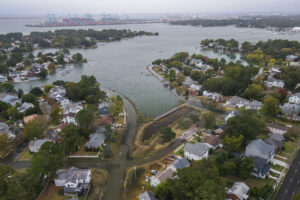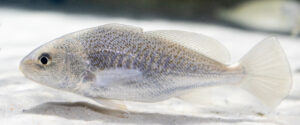Conserving the coastline and its critters
Fellow studies living shoreline designs
by Madeleine Jepsen, Science Writing Intern
Each morning as the sun rises over the Chesapeake Bay, herons swoop across the water and dabbling ducks dip beneath the surface to catch insects, amphibians, or fish for their morning meal. And all the while, the waves lap ashore. These same waves cause erosion that whittles away at the marshy areas this wildlife depends upon. The average homeowner is concerned about erosion, too, but many common shoreline protection measures will damage the habitats that provide homeowners with their beloved morning view.
Hard shorelines like revetments and bulkheads completely separate the land from the water, eliminating the marshy habitat that is home to a variety of plants, insects, and fish that birds and other critters depend on for food. Although they protect the upland shore from erosion, they hinder the flora and fauna that would normally establish there.
One solution, defined by an environmental engineering term—living shorelines—offers protection with minimal disturbance for the waterfront habitats that the animals depend on. Instead of completely blocking off the shore, living shorelines preserve the wetland areas that connect the land and water with engineering methods like marsh sills or oyster reefs.
“This interest in using nature-based features is essentially in line with that,” explains Navid Tahvildari, an assistant professor of civil and environmental engineering at Old Dominion University. “It’s essentially calling for engineering design to catch up with this ecological understanding to design structures that protect the shoreline from waves and erosion, but at the same time, do not disrupt the land-sea interface so that the ecological functions can be maintained.”
Sills consist of freestanding clusters of rocks near the shore that help break waves and allow marsh grasses to flourish. Oyster reefs consist of carefully constructed cement blocks that serve as a surface for these shellfish to grow on. The oysters, in turn, filter the water and create an inviting environment for other shellfish, crabs, and fish.
The Virginia General Assembly has pointed to living shorelines as a preferred method to stabilize shorelines. These projects have gained traction in the last several years, but they are still a relatively new phenomenon. As a result, there are not many guidelines available for coastal engineers like Maura Boswell, a civil and environmental engineering Ph.D. student at Old Dominion University and a Virginia Sea Grant Graduate Research Fellow.
“One of the things that was a little frustrating for me as an engineer is that there’s not a lot of guidance as to how you need to design a living shoreline to make sure that you’re getting the same level of protection that’s provided by, say, a seawall,” Boswell says.
To help address this problem, Boswell is researching the specifics of how living shoreline projects prevent erosion by reducing the strength of the waves hitting the shore. Once she understands how these structures change the waterflow, she can use computer models to design systems that offer the most protection and least obstruction.
“You have to know how it performs in order to figure out how to design it,” explains Shannon Cunniff, the director of coastal resilience for the Environmental Defense Fund and Boswell’s Graduate Research Fellow professional mentor. “Any coastal engineering project has to take into consideration local conditions, but they rely on decades of experience based on how things perform and what you need to consider, so we’re trying to build up that library, that evidence, and be able to say, ‘Ok, this is what you need to consider under these circumstances.”
To help develop these engineering guidelines, Boswell studied two living shoreline projects, a marsh sill, and an oyster reef, taking detailed measurements of the water flow near the structures and over the bottom of the bay. This provides insight into how the structures break up the waves coming to shore—essentially reducing their energy while maintaining the ecology.
For example, with low-sitting oyster reefs, wildlife can cross over the top of the structure to access the marsh, while gaps between the taller rock sills can also allow for interaction between the land and water. Boswell’s measurements of existing structures will allow her to calibrate her model to provide accurate predictions for other structures.
“One of the things that was a little frustrating for me as an engineer is that there’s not a lot of guidance as to how you need to design a living shoreline to make sure that you’re getting the same level of protection that’s provided by, say, a seawall,” Boswell says.
Boswell studied two living shoreline projects, a marsh sill and an oyster reef, taking detailed measurements of the water flow near the structures and over the bottom of the bay.
Developing the model is no small task. Now that field data is collected, Boswell spends hours at the computer, typing out the codes that allow the model to function. Once this time-consuming process is complete, Boswell will be able to enter specifications about the living shoreline structures, such as the height of an oyster reef or how much of a gap there is between marsh sills, to determine how these factors contribute to shoreline protection and erosion mitigation.
“When you take that and put it into the numerical modeling, you can start to look at different scenarios,” Boswell notes. “In other words, you may be able to lower a rock sill based on the way water works and look at the two different types of structures and see what you can learn from each one, and how best to use those types of designs.”
Ultimately, Boswell’s work will increase engineers’ confidence in living shorelines and the protection they offer. The model will also provide insight into how the structures can be designed to maximize the natural connection between the water and the land. This will provide engineers with the knowledge they can apply to the designs for new projects.
“In the long run, this and other people’s work is adding up to a massive amount of information and increasing the knowledge bank that can be drawn upon by organizations when they update their coastal manual or put out guidance for the whole agency,” Cunniff adds. “That’s the kind of thing that can be updated, and when it’s updated, Maura’s work can be pulled right into it.”
TAKEAWAYS
- Living Shoreline projects, a relatively new form of natural infrastructure, use structures such as oyster reefs and marsh sills to prevent erosion along inland waterways
- Although they are gaining traction as an ecologically friendly way for homeowners to protect their shorefront, few guidelines exist for the coastal engineers that design these projects.
- Maura Boswell’s research on the wave dissipation around living shoreline structures will help engineers optimize their designs.
Photos by Lisa Sadler, Science Multimedia Intern, and Aileen Devlin, Digital Storyteller
Video by Lisa Sadler, Science Multimedia Intern
“In other words, you may be able to lower a rock sill based on the way water works and look at the two different types of structures and see what you can learn from each one, and how best to use those types of designs.” -Maura Boswell





